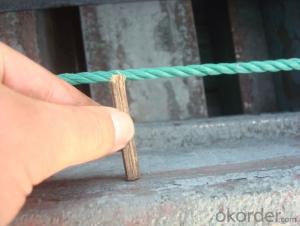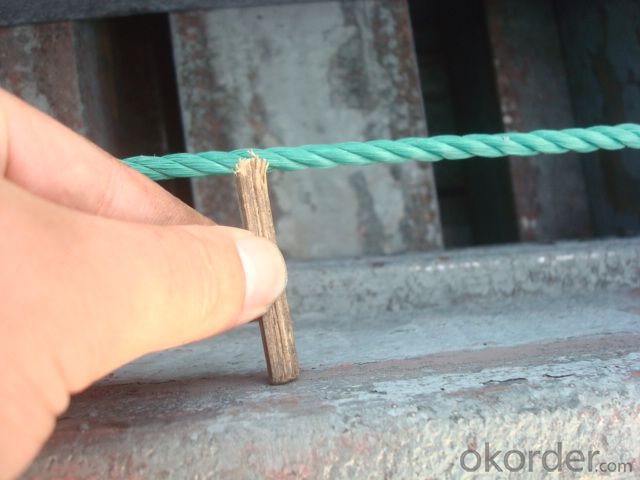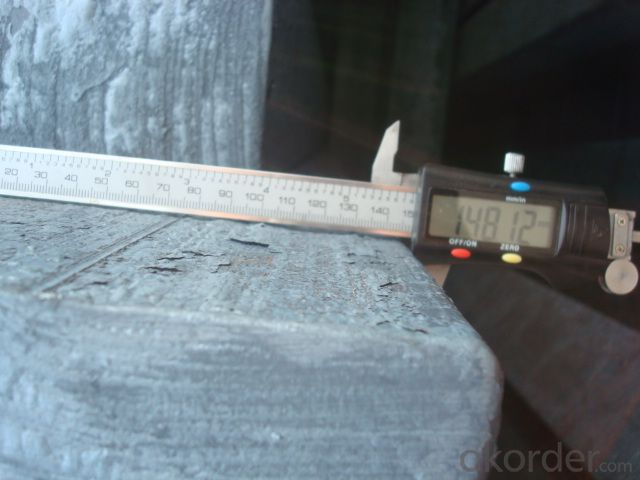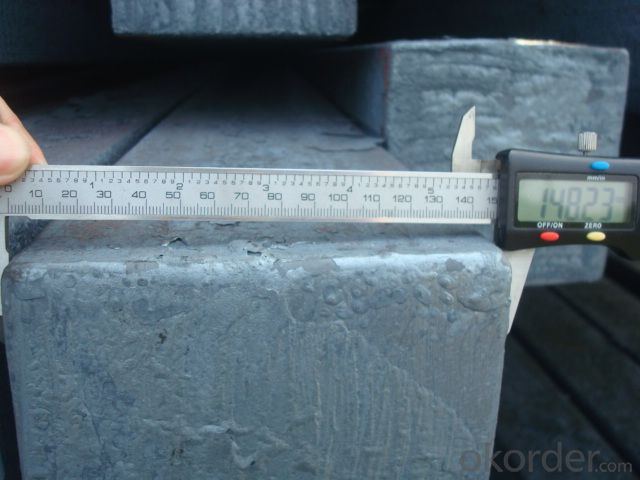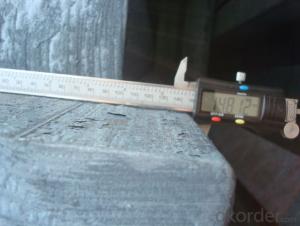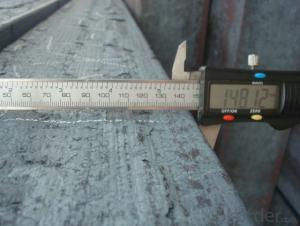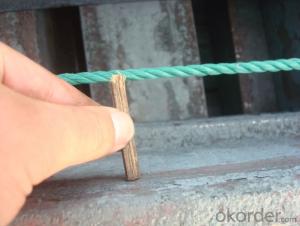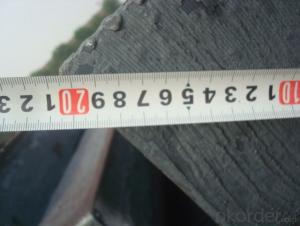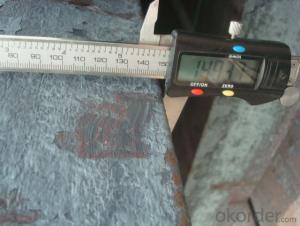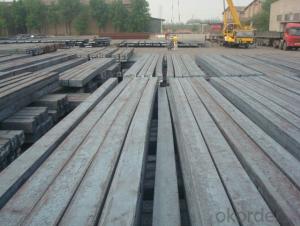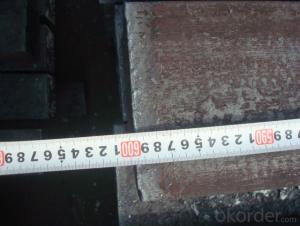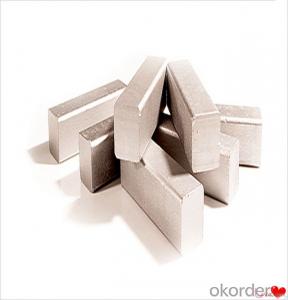Prime Steel Billet Q275, 20MnSi, 5SP,for very good price
- Loading Port:
- Tianjin
- Payment Terms:
- TT OR LC
- Min Order Qty:
- 1000 m.t.
- Supply Capability:
- 20000 m.t./month
OKorder Service Pledge
OKorder Financial Service
You Might Also Like
STEEL BILLET
1.Brief description
Steel billet(ingot) by cogging or breakdown of semi-finished products, is the raw material of all kinds of steel mill. Billet section of square, round, flat, rectangular and abnormity of several kinds of, mainly related to the shape of rolled products.
2.Features
Rectangular billet continuous casting billet and mainly general carbon steel, low carbon low silicon cold-rolled material, high quality carbon structural steel, high strength low alloy steel, special steel, etc.
The billet is mainly divided into two kinds from the shape:
Slab: cross section width and height of the ratio of the larger, mainly used for rolling plate.
Billet: equal cross section width and height, or a huge difference, mainly used for rolling steel, wire rod. ,
Steel billets have distinct characteristics as compared with already furnished steel bars and products. Billets have a specific grain structure, which enables the metal to be processed more intricately. Steel billets are also known for their malleability and ductility, especially when exposed to varying temperatures during shaping and molding.
3.Processing
Steel billets are considered fresh and raw, and they must undergo a series of manufacturing processes before they can be used for various purposes. Billets are made by means of freezing molten liquid, and are later exposed to extremely low temperatures in order to allow the metal to take shape and solidify in chemical structure. The temperature manipulates the metal's physical properties, and tones its strength and durability. The subsequent processes provide the metal's curved mold design so that it can fit the allotted space provided by other machines, which complete the finishing procedures.
4.Pictures
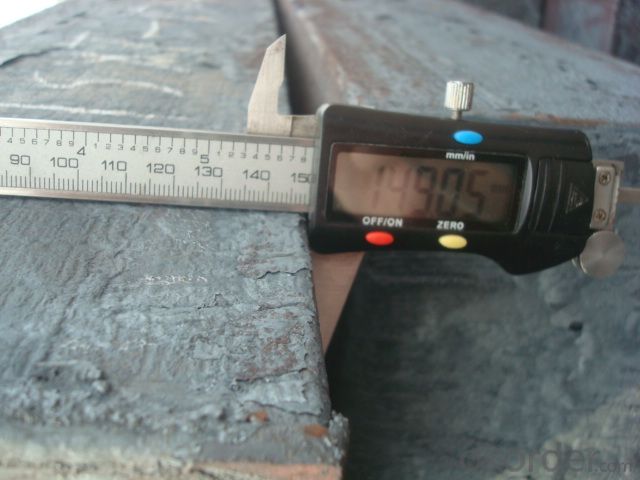
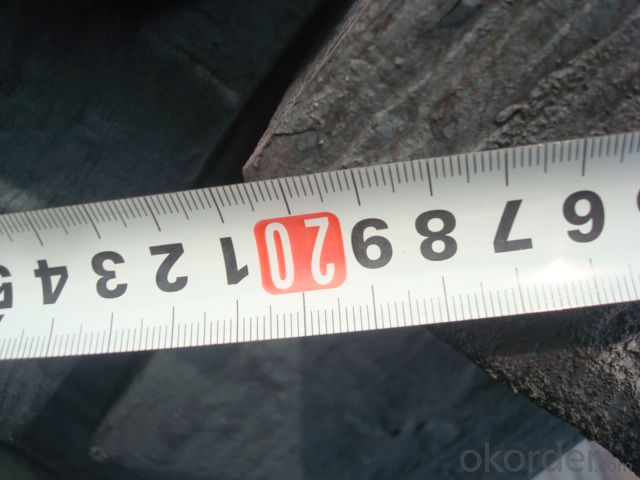
5.Usage
Billets, or ingots (as they sometimes referred to), are not of practical use until they have been formed into more functional shapes and sizes. While they have already been put in the furnace, they still require a series of shaping and molding procedures such as hot and cold working, milling and cutting before they are sold in hardware stores, or used for different applications. The unformed billets, however, can be used in striking currency such as coins and as reserves, similar to gold bars.
6.Detailed specification
Hot rolled billet steel
Size: 50x50mm-180x180mm
Steel Grade: 3SP, 5SP,Q195,Q235,Q255,Q275 Length:3m-12m
MOQ: 1000MT/size
Payment term: TT or LC
Packing: in bulk , bundle
Shipment: by container , bulk vessel
Packaging Details: bundles with steel strips or as customers's requirements
Delivery time: 15-30 days after the deposit
Loading port:Tianjin, or other port China
Origin : China
Inspection:Third party inspection before loading.
- Q: How are steel billets used in the production of automotive fuel systems?
- Steel billets are an essential component in the production of automotive fuel systems. These billets, which are typically made from high-quality steel, serve as the raw material for manufacturing various fuel system components such as fuel injectors, fuel rails, and fuel tank brackets. The first step in using steel billets for automotive fuel systems is the selection of the appropriate grade of steel. The chosen steel should possess specific mechanical properties, including high strength, good weldability, and resistance to corrosion. This ensures that the fuel system components can withstand the harsh conditions and stresses they will encounter during their lifecycle. Once the steel billets are selected, they undergo a series of manufacturing processes. These may include forging, machining, and heat treatment. Forging involves shaping the billets into the desired forms using a combination of heat and pressure. This process ensures that the fuel system components have the necessary strength and durability. Machining is another crucial step in the production of automotive fuel systems. This process involves removing excess material from the forged billets to achieve the desired shape and dimensions. Precision machining ensures that the fuel system components fit perfectly within the overall system, allowing for efficient and reliable fuel delivery. After the machining process, the fuel system components are subjected to heat treatment. This step involves heating the components to specific temperatures and then cooling them at controlled rates. Heat treatment enhances the mechanical properties of the steel, further increasing its strength and toughness. Once the fuel system components are manufactured from the steel billets and have undergone all necessary processes, they are then assembled into the final fuel system. These components play a critical role in the efficient and safe delivery of fuel from the fuel tank to the engine. For example, fuel injectors ensure precise fuel delivery, fuel rails provide a pathway for fuel flow, and fuel tank brackets securely hold the fuel tank in place. In summary, steel billets are a vital ingredient in the production of automotive fuel systems. They are transformed through a series of manufacturing processes, including forging, machining, and heat treatment, to create high-quality fuel system components. These components are then assembled to create a fuel system that enables efficient and reliable fuel delivery for automobiles.
- Q: How are steel billets inspected for surface defects?
- Steel billets are inspected for surface defects through visual inspection, magnetic particle inspection, and ultrasonic testing. Visual inspection involves a thorough examination of the surface for any visible defects such as cracks, pits, or rough spots. Magnetic particle inspection uses magnetic particles and a magnetic field to identify any surface or near-surface defects that may not be visible to the naked eye. Ultrasonic testing utilizes high-frequency sound waves to identify internal and surface defects by analyzing the reflected waves. These inspection methods ensure the quality and integrity of steel billets before further processing.
- Q: What are the main types of steel billet rolling mills?
- The main types of steel billet rolling mills include continuous, semi-continuous, and reversing mills.
- Q: What are the different methods of steel billet surface inspection?
- There are several different methods of steel billet surface inspection that are commonly used in the industry. These methods are designed to detect any defects or imperfections on the surface of the billet, ensuring that only high-quality steel is used in the manufacturing process. 1. Visual inspection: This is the most basic method of surface inspection where trained inspectors visually examine the surface of the billet for any visible defects such as cracks, dents, scratches, or surface irregularities. While it is a simple technique, it is still an important initial step in the inspection process. 2. Magnetic particle inspection: This method involves applying a magnetic field to the billet's surface and then applying iron particles in a liquid suspension. Any surface defects or cracks will cause the iron particles to adhere to the surface, creating a visible indication of the defect. This technique is particularly effective for detecting surface cracks. 3. Eddy current testing: Eddy current testing uses electromagnetic induction to detect surface defects. A probe is passed over the billet's surface, and any changes in electrical conductivity caused by cracks or other defects will generate eddy currents, which can be detected and analyzed. This method is commonly used for detecting surface cracks, but it can also be used to measure the thickness of coatings or detect variations in material properties. 4. Ultrasonic testing: Ultrasonic waves are used to inspect the billet's surface for any defects. A transducer is used to send ultrasonic waves into the material, and any changes in the wave pattern caused by defects on the surface are detected and analyzed. This method is commonly used for detecting surface cracks, but it can also provide information about the internal structure of the billet. 5. Dye penetrant inspection: This method involves applying a colored dye to the billet's surface, which is then removed, leaving only the dye trapped in any defects or cracks. A developer is then applied to make the dye more visible, allowing inspectors to identify and locate any surface defects. This technique is particularly effective for detecting small surface cracks. 6. Laser scanning: Laser scanning uses a laser beam to scan the surface of the billet and create a three-dimensional representation of the surface. This method is useful for detecting surface irregularities, measuring dimensions, and creating digital models for further analysis. Each of these methods has its own advantages and limitations, and they are often used in combination to ensure a thorough inspection of the steel billet's surface. The choice of inspection method depends on factors such as the type of defects being targeted, the size and shape of the billet, and the desired level of accuracy.
- Q: How are steel billets recycled at the end of their lifespan?
- At the end of their lifespan, steel billets are recycled through a process known as steel scrap recycling. This involves collecting the steel billets and segregating them from other materials. The billets are then cleaned to remove any contaminants and sorted based on their composition and quality. The next step in the recycling process is to melt the steel billets in a furnace. The high temperatures in the furnace cause the steel to melt, separating it from any impurities. Various techniques, such as electric arc furnaces or basic oxygen furnaces, can be used for this purpose. Once the steel has melted, it is then cast into new billets or other steel products such as bars, rods, or sheets, depending on the desired end product. The molten steel is poured into molds to form the desired shape and then cooled down to solidify. After solidification, the newly formed steel billets are further processed to remove any surface imperfections and give them the desired dimensions. This can involve processes like hot rolling, cold rolling, or heat treatment to enhance the mechanical properties of the steel. The recycled steel billets can then be used in various industries, including construction, automotive, and manufacturing, to produce a wide range of products. By recycling steel billets, the lifespan of the material is extended, reducing the need for virgin steel production and conserving valuable natural resources. Additionally, recycling steel billets helps to reduce energy consumption and greenhouse gas emissions associated with the production of new steel. Overall, the recycling process for steel billets at the end of their lifespan is a crucial component of the circular economy, promoting sustainability and resource efficiency in the steel industry.
- Q: What are the potential applications of steel billets in the electronics industry?
- The electronics industry can benefit from the potential applications of steel billets. While steel is not traditionally associated with this sector, advancements in technology have allowed for its use in various ways. One potential application is using steel billets to produce electronic enclosures. These enclosures offer superior durability and protection for electronic components. They can withstand harsh environments, provide electromagnetic shielding, and prevent damage from impacts or accidents. Manufacturers have the flexibility to shape and form steel billets into different enclosure designs to meet specific requirements. Another application is in manufacturing connectors and terminals. Steel billets can be machined and formed into intricate shapes and sizes, making them suitable for creating reliable and strong connectors. Steel connectors offer excellent conductivity, ensuring efficient and secure connections between electronic components. Additionally, steel's resistance to corrosion makes it a viable option for connectors exposed to moisture or other harsh conditions. Steel billets can also be used to produce high-strength structural components in electronic devices. These components, such as brackets, frames, or supports, require materials with exceptional strength and rigidity. Steel billets, with their high strength-to-weight ratio, provide the necessary structural integrity and stability. Their robustness ensures the longevity and reliability of electronic devices, especially those subjected to heavy loads or vibrations. Furthermore, steel billets can find applications in manufacturing heat sinks. Heat sinks are crucial for dissipating heat generated by electronic components and preventing overheating. Steel, with its excellent thermal conductivity, efficiently transfers heat away from sensitive electronic parts. By shaping steel billets into heat sink designs, manufacturers can create effective cooling systems that enhance the performance and longevity of electronic devices. In conclusion, steel billets have numerous potential applications in the electronics industry. From electronic enclosures to connectors, structural components, and heat sinks, steel's durability, conductivity, and thermal properties make it a valuable material for electronic device production. As technology continues to advance, the use of steel billets in the electronics industry is expected to expand further, offering more innovative solutions for electronic manufacturers.
- Q: Can steel billets be used for making tools?
- Yes, steel billets can be used for making tools. Steel billets are semi-finished products that are typically hot-rolled into bars, rods, or other shapes. These billets have excellent strength, durability, and resistance to wear and tear, making them suitable for tool production. Tools require materials that can withstand high pressures, cutting forces, and repetitive use, and steel billets provide the necessary qualities to meet these requirements. Additionally, steel billets can be further processed through machining, forging, or heat treatment to enhance their properties, allowing for the production of various types of tools such as wrenches, hammers, chisels, and more.
- Q: How are steel billets used in the production of agricultural machinery?
- The production of agricultural machinery heavily relies on steel billets, which are vital in the manufacturing of different parts and components. These semi-finished metal products serve as the raw material, offering excellent mechanical properties, high strength, and corrosion resistance. To withstand the challenging conditions of agricultural operations, such as uneven terrains and exposure to moisture and chemicals, agricultural machinery like tractors, harvesters, and plows require sturdy and durable structures. Steel billets are the perfect material for constructing these robust structures. Initially, steel billets are melted and cast into a basic shape, usually rectangular or square. Then, they undergo further processing through techniques like forging, rolling, or extrusion to shape them into specific parts needed for agricultural machinery. These parts can include axles, gears, shafts, blades, and brackets. The utilization of steel billets in the production of agricultural machinery guarantees that the final products possess the required strength, durability, and reliability to perform efficiently in farm operations. Steel's inherent properties make it an ideal choice for ensuring the longevity and performance of these machines. Additionally, steel billets offer flexibility in terms of design and customization. Manufacturers can easily modify the shape, size, and dimensions of steel billets during the production process to meet the specific requirements of each machine. This adaptability allows for the creation of more efficient and specialized equipment to cater to various agricultural tasks. In conclusion, steel billets play a critical role in agricultural machinery production by providing the necessary strength and durability for farm operations. Their versatility, strength, and resistance to corrosion make them an ideal choice for manufacturing various components, ensuring the reliability and longevity of these machines in demanding agricultural environments.
- Q: What are the different grades of steel billets?
- There are several different grades of steel billets, each with its own specific properties and applications. Some of the commonly used grades include: 1. Mild Steel Billets: These are low carbon steel billets that are often used in general construction and engineering applications. They have a relatively low tensile strength and are easily weldable and formable. 2. Carbon Steel Billets: These contain a higher carbon content than mild steel billets, giving them increased strength and hardness. They are commonly used in the manufacturing of automotive parts, machinery, and tools. 3. Alloy Steel Billets: These are steel billets that have been alloyed with other elements such as chromium, nickel, or molybdenum to improve specific properties. Alloy steel billets offer enhanced strength, toughness, and corrosion resistance, making them suitable for applications in the aerospace, defense, and oil and gas industries. 4. Stainless Steel Billets: These billets contain high levels of chromium and nickel, which provide excellent corrosion resistance and durability. Stainless steel billets are commonly used in the production of kitchen appliances, cutlery, and medical equipment. 5. High-Speed Steel Billets: These billets are alloyed with tungsten, molybdenum, or vanadium to create a steel with exceptional hardness and heat resistance. High-speed steel billets are primarily used in the production of cutting tools such as drill bits and saw blades. It is important to note that the specific grades of steel billets can vary depending on the manufacturing standards and region. These grades are classified based on their chemical composition, mechanical properties, and intended applications, ensuring that the right steel billet is selected for the desired end use.
- Q: What are the different heat treatment processes applied to steel billets?
- There are several different heat treatment processes applied to steel billets, including annealing, normalizing, quenching, tempering, and case hardening. Annealing involves heating the steel to a specific temperature and then slowly cooling it to relieve internal stresses and improve its machinability. Normalizing is similar to annealing, but the steel is cooled in still air instead of a controlled environment. Quenching involves rapidly cooling the steel to harden it, typically by immersing it in a liquid or oil. Tempering is a process that follows quenching, where the steel is reheated to a specific temperature and then cooled again to enhance its toughness and reduce brittleness. Case hardening is a process where the surface of the steel is hardened while the core remains relatively softer, usually through the addition of carbon or nitrogen.
Send your message to us
Prime Steel Billet Q275, 20MnSi, 5SP,for very good price
- Loading Port:
- Tianjin
- Payment Terms:
- TT OR LC
- Min Order Qty:
- 1000 m.t.
- Supply Capability:
- 20000 m.t./month
OKorder Service Pledge
OKorder Financial Service
Similar products
Hot products
Hot Searches
Related keywords
